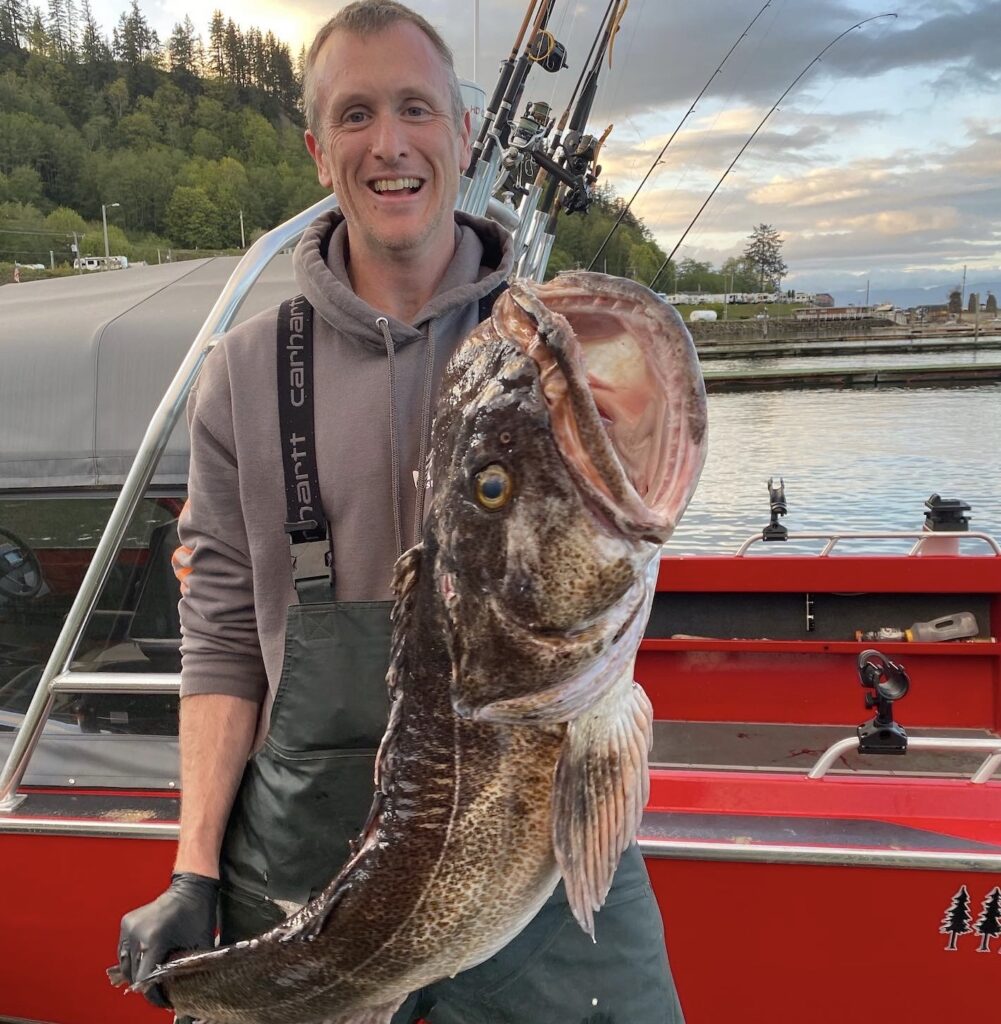
Lingcod is the Washington Coast’s premier bottom fish species due to the combination of accessibility, size and great-tasting meat.
Yes, halibut may be larger on average, but are much less accessible due to the limited days on the water to fish for them.
Rockfish are plentiful and tasty but lack the size that will draw sportsmen in and get really excited about the pursuit of a big fish.
The experience of hooking a nice-sized lingcod is phenomenal! No other fish I’ve angled for in the PNW hits quite like a lingcod.
Their initial strike is meant to completely stun their prey before they come back around to finish the job and eat it whole.
Imagine being hit by a freight train with teeth, and that’s kind of the ling cod bite experience.
Now, ironically, the fight between the bite and getting a lingcod to the boat can often be a let down as they will often come in quite easily and then put up a fight as they get closer.
I think most lingcod expect their initial powerful strike to render their prey quite helpless, so once that “prey” starts pulling them up they aren’t quite sure what to make of the experience…
I’m also convinced that lingcod are one of the dumber predators…I’ve released a lingcod and had them go right back for my jig, like a foot below the water’s surface!
Aggressive, dumb, hungry, and with lots of teeth makes for an awesome fish to angle for!
Where to fish for Lingcod in Washington?
There are three really good locations I’ve had experience with fishing for lingcod around Washington waters and several more I will mention as well:
- Westport / Marine Area 2 is probably your best location to hook a big toothy lingcod.
- Neah Bay / Sekiu aka Marine Areas 4 and 5 is destination lingcod fishing, but far from home for many.
- Puget Sound / Marine Area 6-11 has great access to lingcod fishing and is close to home for many, but can be challenging and very competitive.
- Illwaco / Marine Area 1 – Good location for lingcod with lots of access I just have not fished it.
- La Push / Marine Area 3 – Also a good location, but hardest to access for most.
Westport Lingcod Fishing
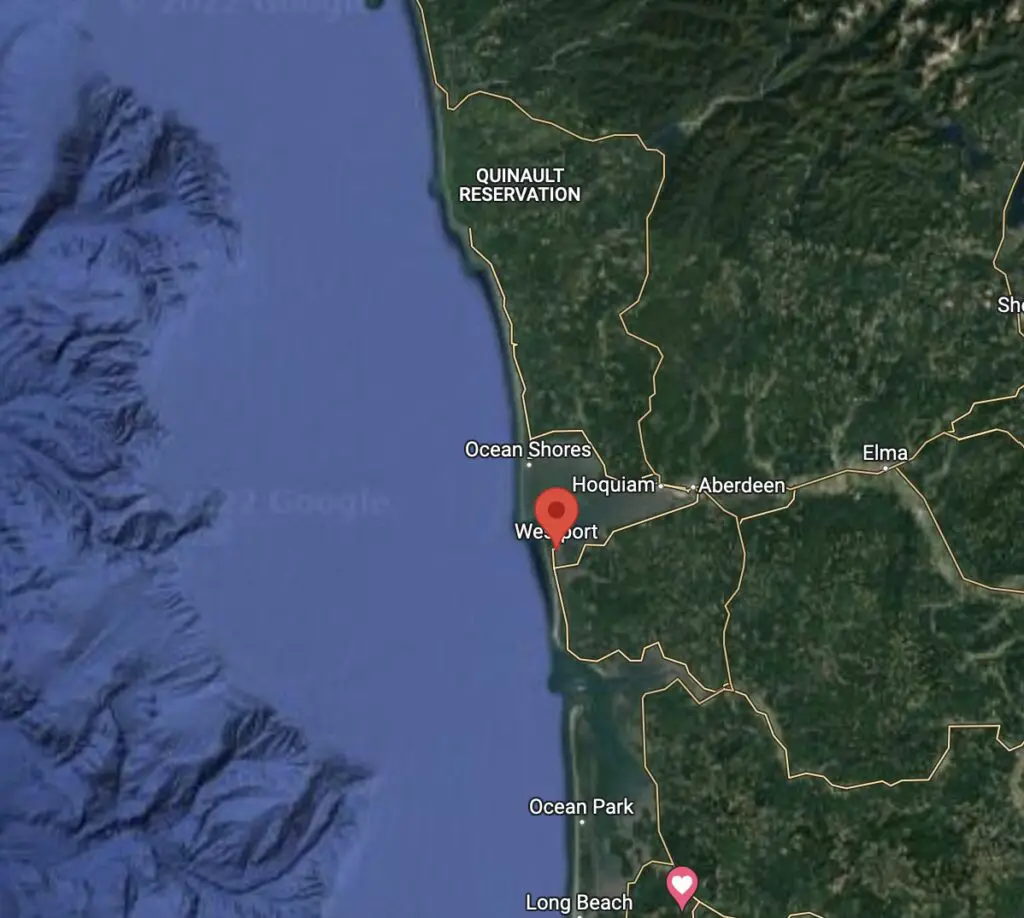
Boats launching from Westport are typically headed for fishing grounds known within the WDFW Regulations as Marine Area 2. There are really three different types of water you will find lingcod within in Westport / MA2:
- Nearshore water shallower than the 30-fathom (180 ft) line.
- Deeper water during halibut openers say 180-500 ft
- Deep water fishing near the Grays Harbor Canyon
The majority of the lingcod fishing season is focused around that nearshore area.
Look for rock piles and rocky reefs, especially north of Westport all the way up to the Sonora Reef (about 20 miles north). Much further north and you are pushing into MA3 and it may be better to just launch from La Push to access.
Look for lingcod not just on the rock pile itself, but also around the rock pile.
While there are several larger rock piles between Westport and Sonora Reef, your strategy out here should take into account the fact that there’s a charter fleet that packs up to 20 clients on board and will absolutely wipe keeper lingcod off of the major rock piles and reefs by a few months into the season.
Nothing against the charter fleet as these are sustainable populations, but if you want to pick through ling dings (cool term for small lingcod) all day, just go to all the same spots the charters have been and you are guaranteed to have slim pickings on big lingcod.
Conversely, the charters will often not visit some of the smaller rock piles at all, and something that looks very small on the standard chart may have more lingcod terrain around it than you might think.
On a very serious note, if you chose to chase ling cod out of Westport, you had better know what you are doing with regard to marine weather safety and crossing major river bars.
I’ve written an outstanding page on the topic of marine weather safety that I would encourage you to review prior to venturing out along with the many other resources you might need to plan a safe trip.
No fish is worth not coming home for, and there are “windows” of good weather to plan a trip around and many other days of marginal/no-go conditions you should avoid.
While we are at it, you should probably get one of these PLB devices for your boat (or even when you are out hiking / hunting).
Simply having an MMSI # on your marine radio won’t help you if you are too far offshore for anyone to pick it up. These devices are connected via satellite and anyone venturing offshore should have one.
Neah Bay / Sekiu Lingcod Fishing
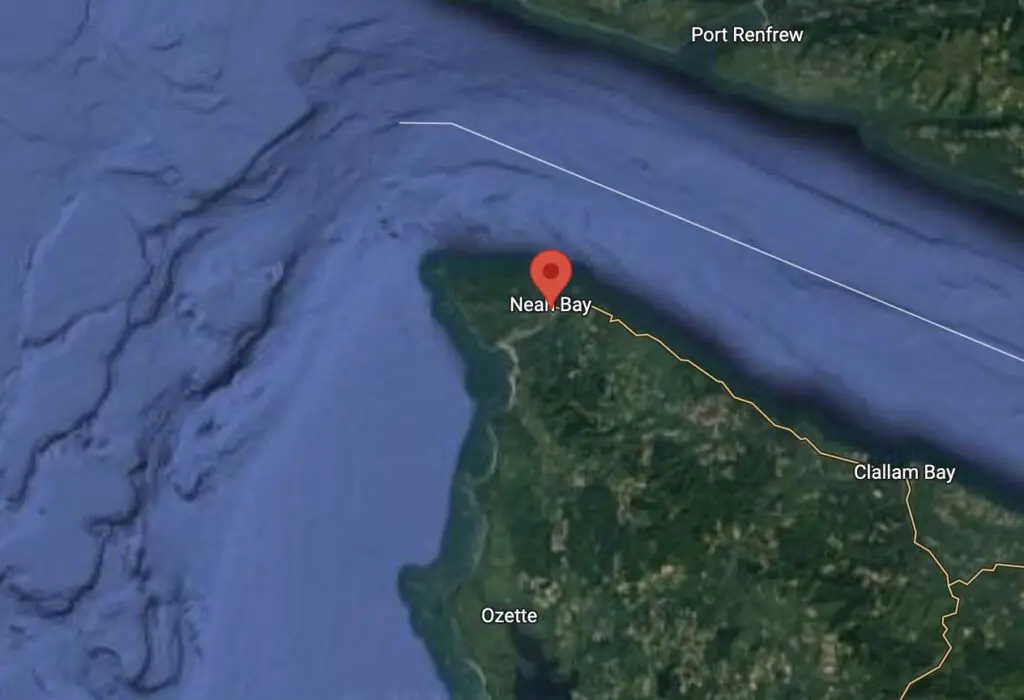
The water around Sekiu and Neah Bay is world-class destination fishing. I plan several trips a year to come out there for all types of sport-fishing opportunities, but lingcod is always on the agenda.
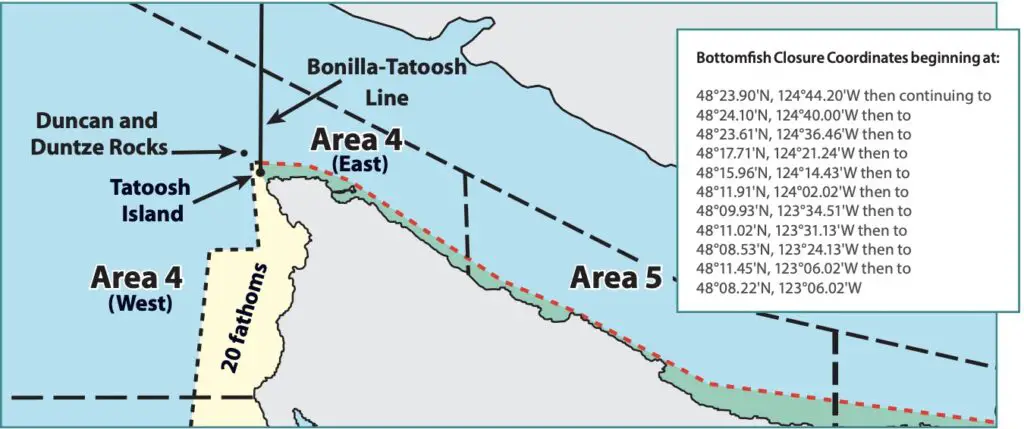
These waters can be divided into Marine Area 4 and Marine Area 5. The seasons are quite different typically and even with MA4 there can be a big difference between East of Tatoosh vs West of Tatoosh.
MA5 and MA4 East are considered part of the Strait of Juan De Fuca whereas MA4 West is the Pacific Ocean.
Within MA5 you will find ling cod around structure and rocky areas around points and seasons will tend to follow those of the Puget Sound lingcod seasons. For more details on lingcod fishing around Sekiu check out our page on the topic.
The waters west of Sekiu will often be protected from the worst of the weather systems that frequently approach from the west and southwest of the Washington coast. However, weather and onshore flow from the Northwest or East can be problematic.
The waters east of Sekiu can be more exposed to weather and swells from the west, as you head towards Slip Point and Pillar Point
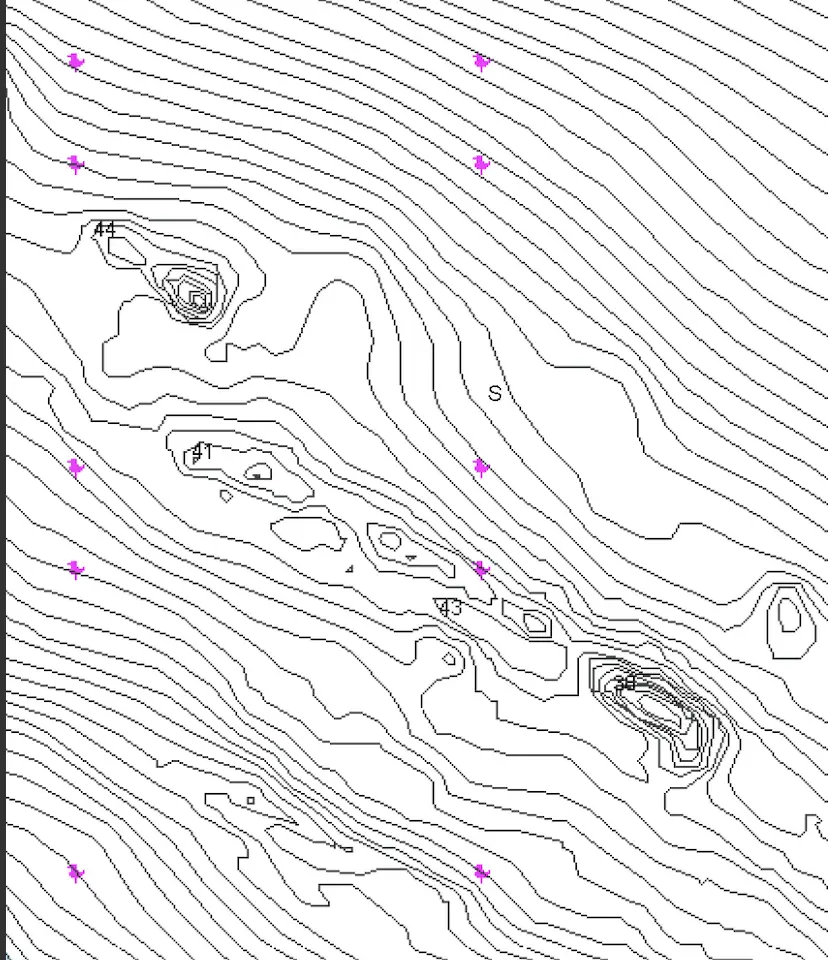
Within MA4 both West and East, you will find an abundance of rock piles and reefs that look like the above on a marine bathymetric chart, that holds a significant amount of ling cod.
As you “round the corner” past Waadah, but especially Tatoosh Island you will be fully exposed to the marine weather environment of the Pacific Ocean. Out here you will often find incredible lingcod fishing in the nearshore areas.
Just as with fishing out of Westport you need to be very aware of how marine weather safety works, though you don’t have to cross a river bar, and will often have many more decent windows to fish for lingcod or other species.
Puget Sound Lingcod Fishing
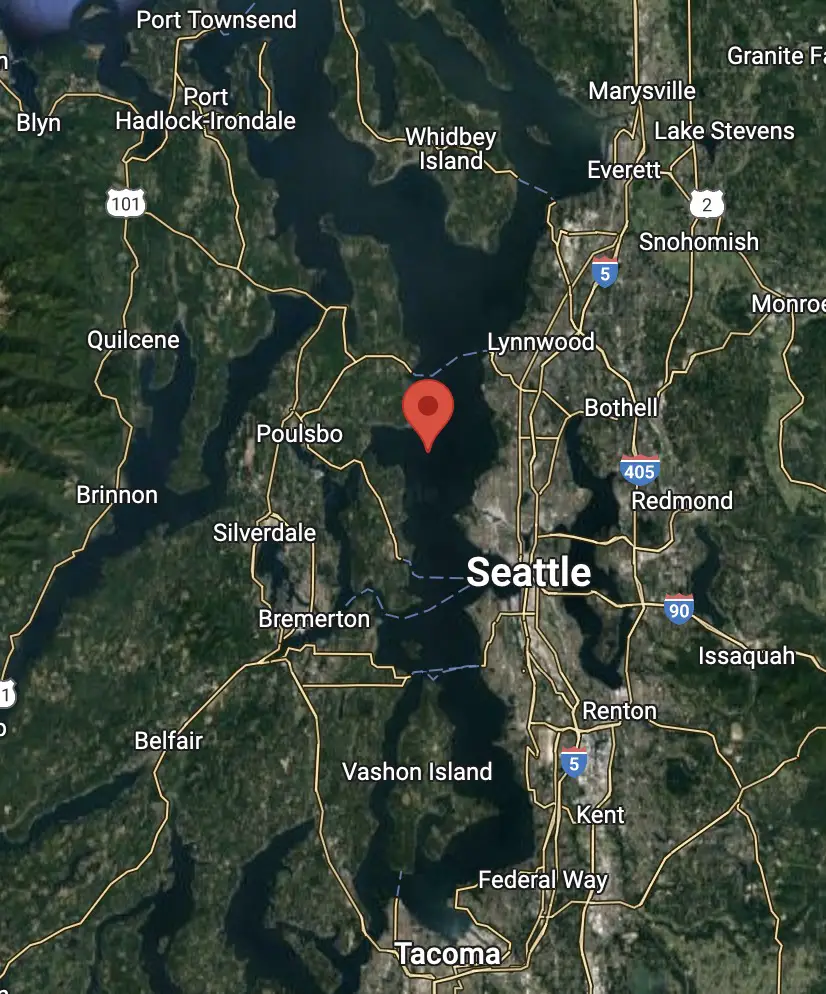
The Puget Sound offers great opportunities to fish for lingcod, but given how close to home it is for many anglers, you should also expect significant competition, a season based around a slot limit, and greater challenges getting these fish to bite.
The most popular place to fish for lingcod is in Puget Sound, but far from the only (or even best?) is Possession Bar just south of Whidbey Island. It’s not uncommon to see hundreds of boats fishing for lingcod on Possession on the opening day of the season.
I’ve often heard it said that the best fishing for lingcod on Possession is the first week of the season and the last week.
That’s because the lingcod within the slot limit on the bar quickly gets fished out by the massive fishing pressure that occurs that first week.
Over time, as fishing pressure spreads on to other spots and other fishing opportunities, the numbers will come back as ling cod migrate around from deeper water into the vacated ambush spots on the bar.
This makes the last week of the season fairly decent as well.
You can target keeper lingcod all over Puget Sound in areas where it is open though.
Look for ambush spots around underwater structures such as wrecks, jetties, and points as likely places to target.
Weather is less of an issue on the Puget Sound, but boats sink every year from not applying enough caution.
There are places that can be very exposed and create significant marine weather hazards, and Possession Bar is definitely one such area to be aware of.
Best Lingcod fishing rigs
There are a number of successful methods for targeting ling cod to explain here and some are more successful based on the area fished, which I will attempt to highlight as I discuss each one.
Fishing with Bait for Lingcod
Bait, which is a hugely popular and successful method to target lingcod, must be divided into live vs dead bait.
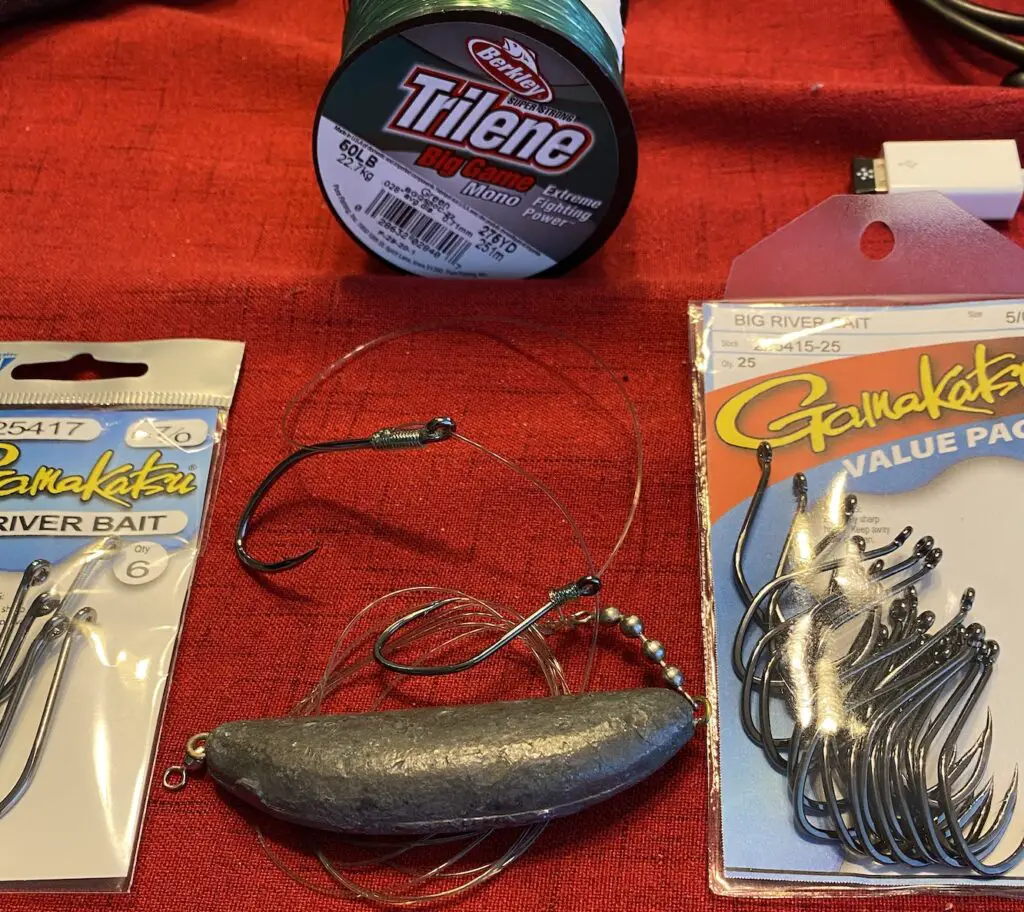
Let’s start with dead bait and the standard herring (size green to black is most typical). When I fished out of Westport on a charter fishing for lingcod, everybody was mooching herring on a 2- 2.5 ft leader off the bottom and we got nearly all of our lingcod that way.
Use 50 lb mono or greater to avoid the sharp teeth of a big ling shredding your leader.
I’ve used the technique significantly myself and it’s a fun and very effective way to target aggressive ling cod. This technique has limited utility in Puget Sound and other highly competitive places to fish for ling cod.
Live bait is always superior to dead bait and is considered necessary to hook bigger lings in competitive areas.
In Puget Sound such as Possession Bar, people will often use live sand dabs caught in the sandy shallows all around Marine Areas 9 and 10.
Typically, sand dabs around the size of your hand are what’s preferable. Larger than that, and you may want to consider keeping it and eating it, sand dab and flounder are really good eating!
In places with more rockfish populations, such as all of the Pacific Ocean, Strait, and the San Juan Islands (MA7), the Kelp Greenling is like lingcod candy! You will often catch these smaller bottom fish in shallow water (< 50 ft) while targeting other rockfish species.
Smaller kelpies are incredible lingcod baits. I’ve seen multiple lingcod following a kelpie up to the surface to attack it! Larger kelp greenling are also great eating, so consider adding it to your fish box if the regulations in your area permit it.
Lastly, I would be remiss if I didn’t mention the infamous hitchhiker lingcod scenario. What is a hitchhiker ling? Only the most common way to catch monstrous lingcod in shallow nearshore water!
The hitchhiker scenario starts by first targeting a rockfish species of some sort, often black rockfish.
Second, after you hook said rockfish, your rod will all of a sudden load up dramatically, almost like you are hung up on something, but it will continue to come towards you as you pull on it and reel.
If you suspect you’ve got a hitchhiker ling, you need to very steadily reel to the surface and keep your rod tip low in the water or just above.
A hitch-hiker ling is not hooked in any way, shape, or form and will let go sometimes when they see the boat or for sure if their head is lifted out of the water.
The technique is to keep their head in the water by keeping the rod tip low and getting someone to slide a net behind the fish.
As the rod tip is lifted, move the net aggressively up to scoop up what will often be a significantly large lingcod.
Fishing with Jigs for Lingcod
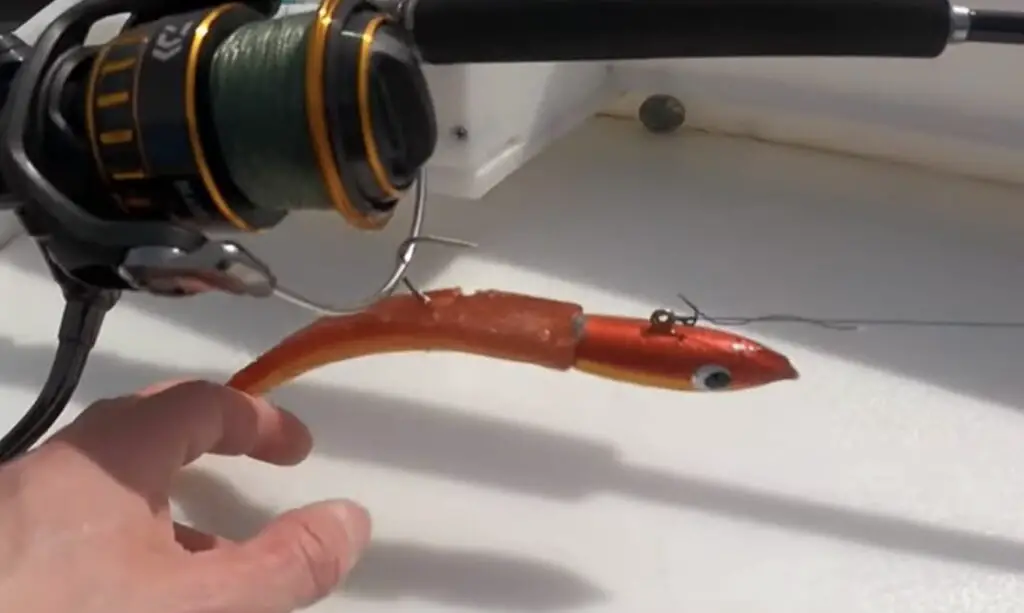
There are multiple jigs that can be used to fish for ling cod, but I have a few favorites I will highlight here.
For starters, one must consider that a lingcod has a ridiculous amount of razor-sharp teeth. Any jig you use with soft plastics is going to get absolutely shredded over time. That’s why my new favorite jig is the Lancer Jig.
These combine a nicely painted jig-head paired with a matching plastic body that is “soft” but also incredibly durable. I’ve not yet lost the soft plastic before losing the jig by sticking it on a rock or something.
I love to use soft plastics like the Berkely gulps as well, but these get shredded quite fast and you will find yourself going through them quickly which gets expensive fast!
I will tend to use jigs between 2-7 oz for nearshore lingcod fishing.
Anglers will often use pipe jigs which are much heavier for deep-water lingcod fishing.
Trolling for Lingcod
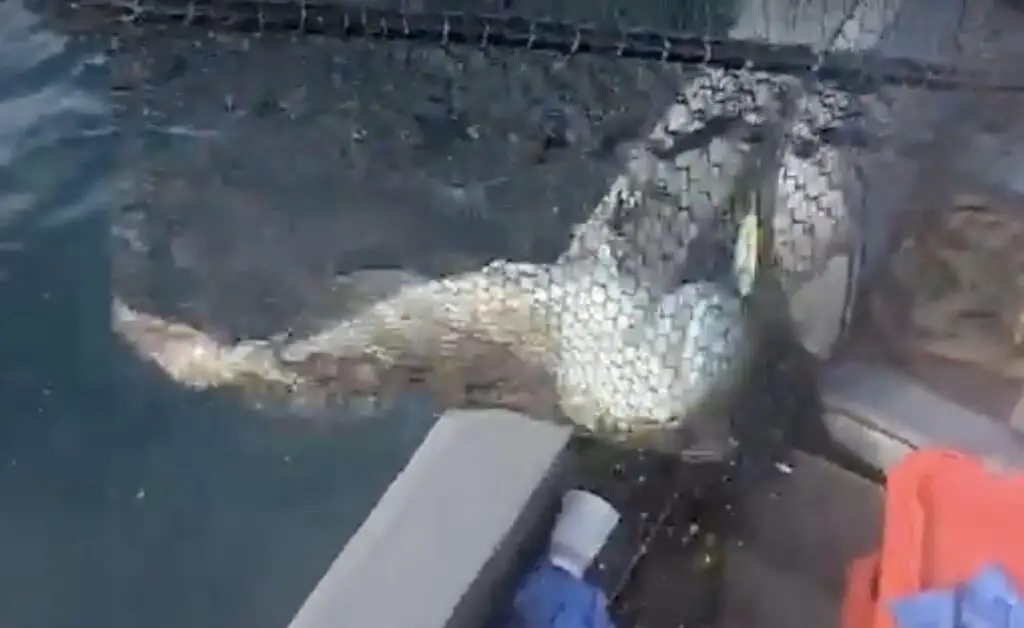
Okay, you may have responded with a strange look at the idea of trolling for lingcod, but hear me out…
In the summertime when both salmon and lingcod fishing seasons overlap, you can have an awesome experience of using a typical salmon trolling setup, but working around reefs, points, and rock piles and catching salmon, lingcod, and rockfish all in the same area with the same gear!
There is something about a multi-species opportunity that gets me all excited!
I tend to prefer spoons like the Kingfisher 3.0 or Coho Killer for putting any species in the box.
If you do this with bait such as an anchovy in a helmet, expect to have non-stop action as you will hook many rockfish!
And you may have to check your gear more often than you like due to a rockfish’s tendency to strike and shred whatever you put down there, without necessarily getting hooked.
Using trolling spoons will give a nice balanced opportunity to hook any species without having to check your bait constantly to know that it’s still fishing.
How to fish for Lingcod
We’ve talked a bit about technique already while covering rigs and gear, but let’s get into some broader strategies as well.
I’ve written a full reference on how to fish for Lingcod you should access here.
Processing your catch of lingcod
Okay, so you’ve followed all of the handy advice on this wonderful page about lingcod, and now you have caught a few and want to process your catch for the highest culinary value.
I like to start with a handy video that shows how to fillet a new species of fish. Why not go to the MeatEater for this?
Now that you have an idea of the technique, a few other tidbits. Please, please, please keep your catch on ice. Don’t just throw it in the hole like it’s a rockfish, treat it like it’s a salmon (just kidding I treat all my fish with utmost respect!).
In general, for bottom fish like rockfish and lingcod, you need the right fillet knife to make quick work of things and I have the best fillet knife just for the job!

Black Titanium Nitride Coated – High Carbon 7CR17MOV-X Vacuum Treated Steel – Meat, Boning Knife – Sheath – NSF Certified
Okay, I have to confess something here…I’m freakin in love with this knife!
This is the sharpest knife I’ve ever owned and holds an edge beautifully. Exactly what I need to make quick work of any bottom fish, or maybe any meat period.
And just look how sexy this knife is! Dalstrong makes more knives in this same series (called the Shadow series) and the handle is just so fun to grip (modeled after the stealth fighter!).
It really takes the chore out of any knife work.
While you are at it, you might as well sharpen your shadow series fillet knife with a premium whetstone that Dalstrong recommends to keep that razor sharp edge.
Lastly, you should probably get some fillet armored gloves now that you’ve tossed all your semi-dull fillet knives!
Final thoughts
I hope all of the above was helpful, please consider supporting the blog by clicking on one of the Amazon links, it earns us a small commission, but doesn’t change the price of any of the items. I only link to products I buy, use, and enjoy!
Finally, if you have a comment or question, please drop it in the comments below, I usually get back to them within a few days if not earlier. Don’t worry if your comment doesn’t show up immediately, if it’s your first time, it’s sometimes held in a spam queue.